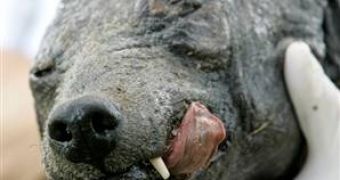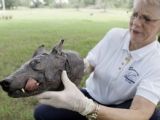In US and Europe it is called the Boogie Man, while in Latin America (specifically Mexico and Puerto Rico) it is known as the Chupacabra (the Spanish for "Goatsucker"): a type of mythical vampire-creature that sucks the blood of the goats and the chickens and frightens the children.
That's why Phylis Canion, a hunter that roamed Africa for four years, believed that could be the roadkill she encountered in August 2007 outside her ranch, in Cuero, 80 mi (128 km) southeast of San Antonio, Texas. The creature was so odd, that she kept its head in the freezer.
The animal had big ears, large fanged teeth and grayish-blue, almost hairless skin. Canion and her neighbors discovered the 40-pound (18-kilogram) bodies of three "chupacabras" in July outside her ranch.
The saved head could solve the mystery through DNA analysis. Canion believed that a chupacabra could have killed up to 26 of her chickens in the last two years, because the chickens weren't eaten or transported, they were just drained of blood and thought that heavy rains chased away the beasts out of their dens.
"What folks are calling a chupacabra is probably just a strange breed of dog. I'm not going to tell you that's not a chupacabra. I just think in my opinion a chupacabra is a dog. The "chupacabras" could have all been part of a mutated litter of dogs, or they may be a new kind of mutt. This particular canine may simply have a preference for blood, letting its prey bleed out and licking it up." said veterinarian Travis Schaar of the Main Street Animal Hospital in nearby Victoria.
Now the DNA analysis made at Texas State University has settled the mystery: the animal was just a plain old coyote. "The DNA sequence is a virtually identical match to DNA from the coyote. This is probably the answer a lot of folks thought might be the outcome. I, myself, really thought it was a domestic dog, but the Cuero Chupacabra is a Texas Coyote.'' biologist Mike Forstner told San Antonio television station KENS-TV.
"The testing provided an opportunity to demonstrate how science answers questions. This is fun, not scary, but if people are worried about the chupacabra, it is probably even more important that we explain the mystery. Folks can fear what they don't understand, and a big part of the goal in science is to explain the natural world. Skin samples have been taken to try to determine the cause of the animal's hair loss," said Forstner.

 14 DAY TRIAL //
14 DAY TRIAL // 
